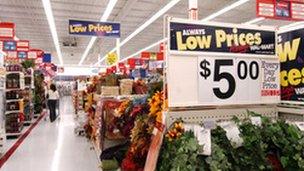US retail sales beat forecasts
- Published

US consumers shrugged off higher taxes to boost retail spending by 1.1% in February from the month before.
It was the biggest rise in five months.
About half the increase was due to higher petrol prices, but consumers also increased spending on a range of other goods, from cars to clothing to homeware and furniture.
The government figures surprised economists, who thought payroll tax increases - which went into effect in January - would hurt spending.
A separate government release showed that businesses are also optimistic, with inventories increasing by 1% in January.
Growing inventories indicate that businesses expect demand to pick up in the future, and sluggish inventory growth was one of the contributors to tepid economic growth in the last quarter.
'Headwinds'
Commenting on the consumer spending data, Chris Williamson, chief economist at Markit, said: "The consumer remains in an upbeat spending mood.
"The data add to the view that the US economy continues to show reassuring resilience in the face of fiscal headwinds."
Those fiscal headwinds are due to government negotiations over federal spending. Congress has been at loggerheads over the need to cut the federal deficit.
The payroll tax cuts had initially been implemented after the recession to boost spending, but they were allowed to expire in January as a way to boost government coffers.
This meant that someone earning $50,000 (£33,500) would take home $1,000 (£670) less this year.
Despite this, consumers continued to take out their wallets, possibly as a result of better jobs figures and a more positive consumer outlook.
Economists say this is an encouraging sign, as consumption makes up more than 70% of economic activity in the US.
Many now believe the US economy will grow at a modest 2% this year.